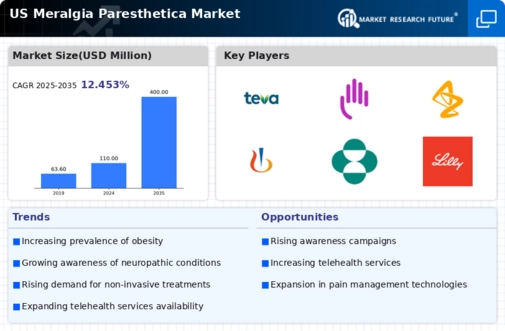Rising Incidence of Obesity
The increasing prevalence of obesity in the US is a notable driver for the meralgia paresthetica market. Obesity is linked to various health complications, including nerve compression syndromes such as meralgia paresthetica. According to the CDC, approximately 42.4% of adults in the US were classified as obese in 2017-2018, a figure that has likely increased. This condition can lead to heightened demand for treatment options, as individuals seek relief from symptoms associated with nerve compression. The growing awareness of obesity-related health issues may further propel the market, as healthcare providers focus on preventive measures and treatment strategies. Consequently, the rising incidence of obesity is expected to significantly impact the meralgia paresthetica market, driving both awareness and treatment options for affected individuals.
Growing Geriatric Population
The aging population in the US is a significant driver for the meralgia paresthetica market. As individuals age, they become more susceptible to various health conditions, including nerve-related disorders. The US Census Bureau projects that by 2030, all baby boomers will be older than 65, leading to a substantial increase in the geriatric demographic. This population is more likely to experience conditions that contribute to meralgia paresthetica, such as diabetes and obesity. Consequently, the demand for effective treatment options is expected to rise. Healthcare systems may need to adapt to accommodate the needs of this growing demographic, potentially leading to increased investment in research and development for targeted therapies. Thus, the expanding geriatric population is poised to significantly influence the meralgia paresthetica market.
Increased Focus on Pain Management
The heightened emphasis on pain management strategies in the US healthcare system is driving the meralgia paresthetica market. Chronic pain conditions, including meralgia paresthetica, are increasingly recognized as critical health issues that require comprehensive management approaches. The National Institutes of Health has reported that chronic pain affects approximately 20.4% of adults in the US, underscoring the need for effective treatment modalities. As healthcare providers prioritize pain management, there is likely to be a surge in demand for therapies specifically targeting nerve-related pain. This focus may lead to the development of innovative treatment options, including pharmacological and non-pharmacological interventions. Consequently, the growing emphasis on pain management is expected to positively impact the meralgia paresthetica market.
Expansion of Rehabilitation Services
The expansion of rehabilitation services in the US is emerging as a key driver for the meralgia paresthetica market. Rehabilitation programs that focus on physical therapy and occupational therapy are increasingly recognized for their role in managing nerve-related conditions. These services aim to alleviate symptoms and improve the quality of life for individuals suffering from meralgia paresthetica. As healthcare providers expand their rehabilitation offerings, patients may gain better access to tailored treatment plans. The integration of multidisciplinary approaches in rehabilitation can enhance recovery outcomes, potentially leading to increased patient satisfaction. This trend suggests that the growth of rehabilitation services will likely contribute to the overall development of the meralgia paresthetica market.
Advancements in Diagnostic Techniques
Technological advancements in diagnostic techniques are transforming the landscape of the meralgia paresthetica market. Enhanced imaging modalities, such as MRI and ultrasound, allow for more accurate identification of nerve compression and related conditions. These innovations facilitate timely diagnosis, which is crucial for effective treatment. As healthcare providers increasingly adopt these advanced diagnostic tools, the market is likely to experience growth. The ability to diagnose meralgia paresthetica with precision can lead to improved patient outcomes and satisfaction. Furthermore, the integration of artificial intelligence in diagnostic processes may streamline evaluations, potentially increasing the number of diagnosed cases. This trend indicates a positive trajectory for the meralgia paresthetica market, as better diagnostic capabilities may lead to increased treatment uptake.

















Leave a Comment